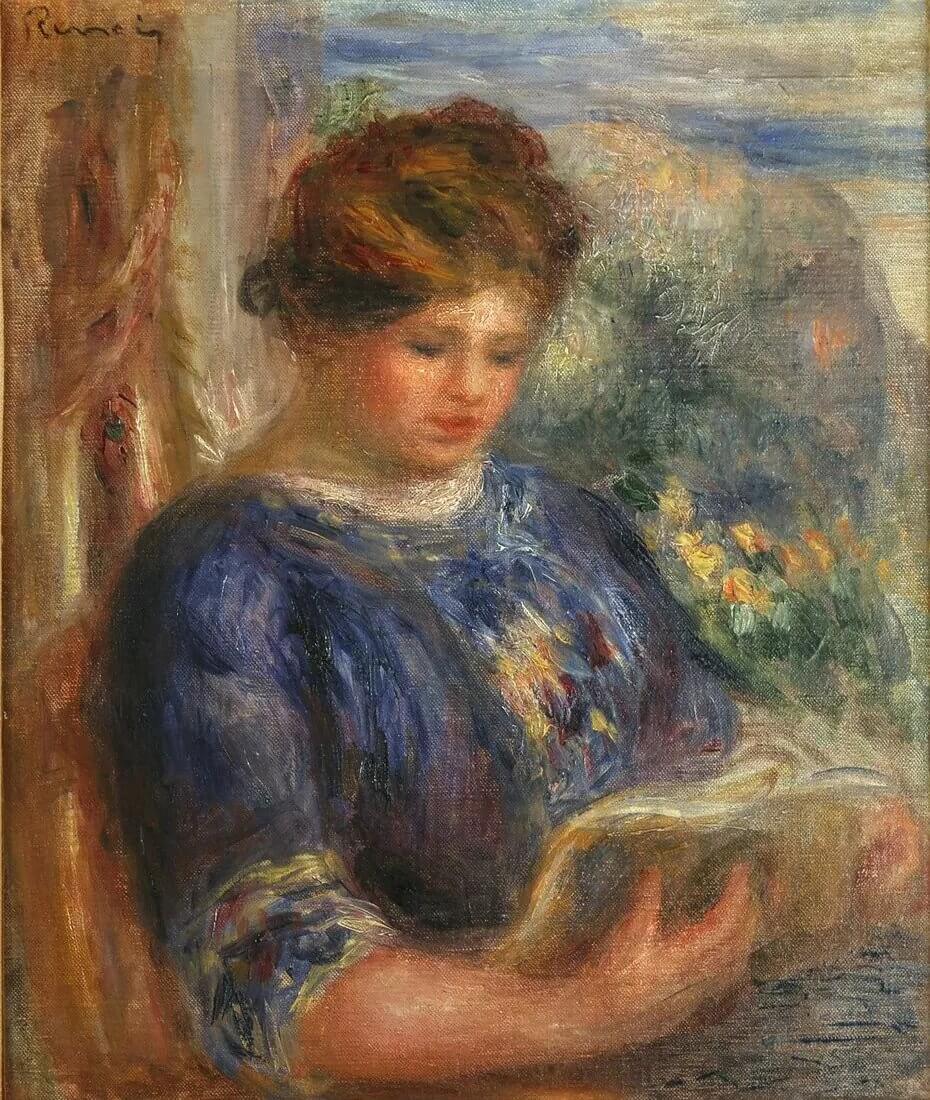It’s hard not to discuss the Impressionism movement of the 19th century and not mention one of its most famous artists, Pierre-Auguste Renoir. As one of the pioneers of the movement, Renoir showed the beauty of everyday life and how art and the real world could blend together on the canvas. Renoir lived a full life, reaching the ripe old age of 78 before he died. It’s hard to overstate how much of an impact his work had on the art community, both during his time and beyond.
Biography
Early Life
Pierre Auguste Renoir was born in Limoges, Haute-Vienne, France, in 1841, as one of seven children. Renoir was born to a working-class family, and when he was four years old, they all moved to Paris so his father, Leonard, could find more work opportunities.
Renoir’s artistic talents developed quickly, and those around him could tell that he was adept at painting (although singing was another passion of his). When he was 13, Renoir began an apprenticeship at a porcelain factory. Part of his work was painting floral patterns on plates and other products, including fine China. In addition to painting porcelain, he also painted ceiling fans and cloth panels for missionaries to take on their journeys abroad.
In 1858, the factory switched to machine processing, so Renoir was out of a job. He would enroll in art classes at École des Beaux-Arts to develop his talents further and see where they would take him.
Education
In 1862, Renoir started studying under Charles Gleyre, a Swiss painter of some note. While Renoir’s artistic style didn’t mimic Gleyre’s, he did learn discipline, which allowed him to focus on painting and refine his artwork to be more professional. It was also during this time that Renoir would meet other contemporary artists, including Claude Monet, Alfred Sisley, and Frédéric Bazille.
Death
Pierre Auguste Renoir died at Cagnes-sur-Mer in December 1919 at the age of 78. In 1892, Renoir developed rheumatoid arthritis, which severely hampered his ability to paint. Nonetheless, he persevered and continued painting well into his twilight years, although he required more assistance as his condition worsened. He also dabbled in pottery during this period, calling back to his early days making porcelain in Paris.
Impressionism Movement
During his time at school, Renoir and his contemporaries sought to break free from the traditional artistic means of expression and branch out into something new. Impressionism aimed to capture subjects within their scene as a moment in time, illustrating how each component of the scene would blend to create something more profound. Light was also a critical element in Impressionism, as artists like Renoir wanted to show how the light of the moment affected everything within the frame.
For Renoir, success first came in 1868 with an exhibition at the Paris Salon, which often showcased the works of students at École des Beaux-Arts. One notable piece during this exhibition was Lise with a Parasol, which depicted Renoir’s lover Lise Trehot in a white muslin dress with a small parasol to block the sunlight.
Oddly enough, Renoir’s first exhibition was in 1864, but since France was at war with Prussia at the time, it was hard for artists like him to gain notoriety. It took ten years before the first official Impressionism exhibition in 1874. At the time, the art community mostly derided the movement, although Renoir was something of an exception, with many critics and attendees preferring his work over others at the show.
In 1874, Renoir’s art also took a dramatic turn as he was no longer able to stay at a friend’s estate in Fontainebleau. Without access to such serene natural settings, Renoir had to find inspiration elsewhere.
At the second Impressionism exhibition of 1876, Renoir displayed many portraits, as he hoped he could make money as a skilled portrait artist. He also showcased various works at the third exhibition but not subsequent showings. After the third exhibition, he would resume his partnership with the Paris Salon.
By the end of the 1870s, Renoir was an established painter, allowing him more freedom and flexibility to stretch his legs and visit other parts of the world. In 1881, he visited Algeria, Spain, and Italy to see other contemporary artists and gather inspiration for new pieces. In 1883, he stayed on the isle of Guernsey in the English Channel over the summer, creating 15 paintings in about a month.
Throughout the 1880s, Renoir painted a variety of scenes, including landscapes, parties, social gatherings, and more. However, in 1890, he married a dressmaker named Aline Victorine Charigot, with whom he had already had a child in 1885. After getting married, Renoir’s work turned more insular, focusing on his wife and family. The pair had three sons, Pierre, Jean, and Claude Renoir.
The Legacy of Pierre Auguste Renoir
As such a prolific painter, Renoir’s work has permeated art culture and served as something of a time capsule of the era in which he lived. Renoir was also one of the lucky artists who was appreciated in his time, meaning he understood the value of his work and what it meant to others. Late in his life, he would visit the Louvre and see his paintings displayed alongside the Old Masters, illustrating how important his work was in the grander scheme.
It’s easy to look at Renoir’s pieces and say that they’re just “pretty” to look at. However, upon closer inspection, the meaning behind these works is on full display. As one such critic, Albert Aurier, remarked in 1892, “With such ideas, with such a vision of the world and of femininity, one might have feared that Renoir would create a work which was merely pretty and merely superficial. Superficial it was not; in fact, it was profound, for if, indeed, the artist has almost completely done away with the intellectuality of his models in his paintings, he has, in compensation, been prodigal with his own.”
Overall, Renoir’s work is remarkable, not just from a technical perspective. His artistic eye was able to capture the spirit of a scene, not just replicate it as if it were a photograph. In fact, if you were to compare photos to Renoir’s work, they would be as unique as night and day.
Famous Works of Pierre Auguste Renoir
Thanks in part to Renoir’s prolific livelihood, it’s relatively easy to own a piece of art history. Here are several of Renoir’s works available to purchase at auction.
Pierre-August Renoir “Baigneuse Assise“
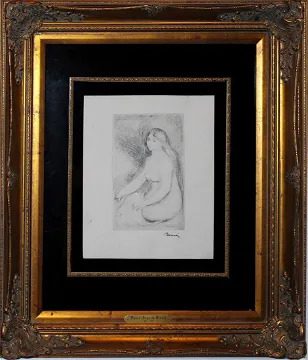
One of Renoir’s favorite subjects was the female nude, and this piece is an etching of a naked woman sitting with a cloth or sheet wrapped around her legs. This etching doesn’t go into significant detail, instead focusing on the curvature of her body, hair, and face.
Pierre-August Renoir – Etude Pour Une Baigneuse
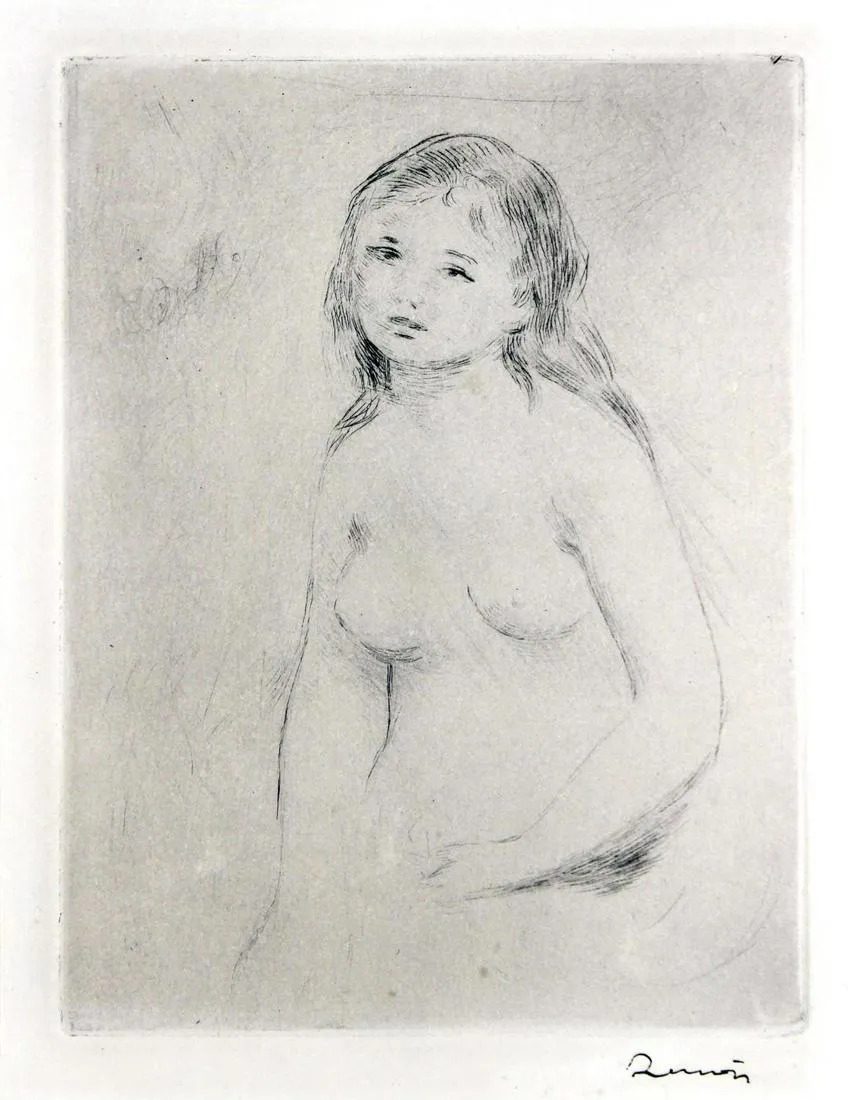
Here we have another nude etching of a young girl sitting slouched within the frame. Renoir only rendered the top half of her body, again focusing on the curved lines of her features instead of filing in minute details.
Pierre-August Renoir – Impressionist French Girl Claude Monet Era Style 100 Years Old+
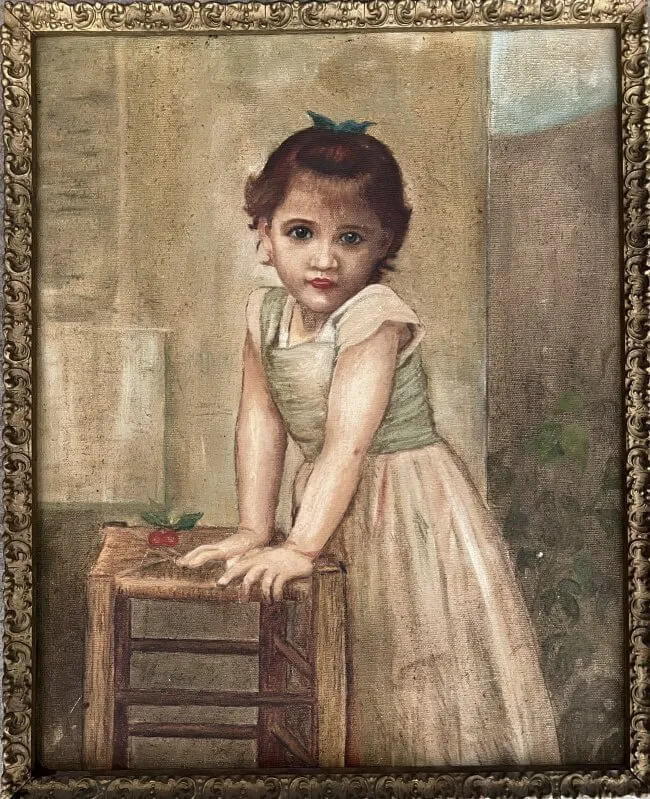
This piece is a finished painting of a young girl standing and leaning on a chair or stool with a piece of holly next to her hands. She looks directly at the viewer while wearing a modest green and white dress.
Pierre-August Renoir – Une Mere Et Deux Enfants
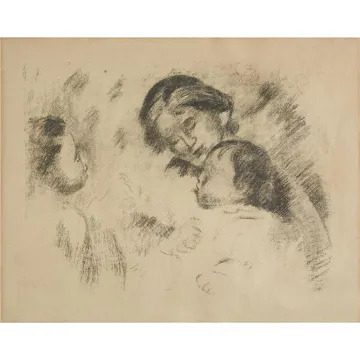
This artwork is a lithograph depicting a mother with two young children. This piece only depicts their heads, although you can see the faint outlines of the mother’s hands and left arm.
If you are looking for artwork by Pierre Auguste Renoir, call us now at 267-687-8378 or leave an inquiry on Dane Fine Art. We are happy to help you find the artwork you are looking for. Explore more art and artists with Dane Fine Art.

